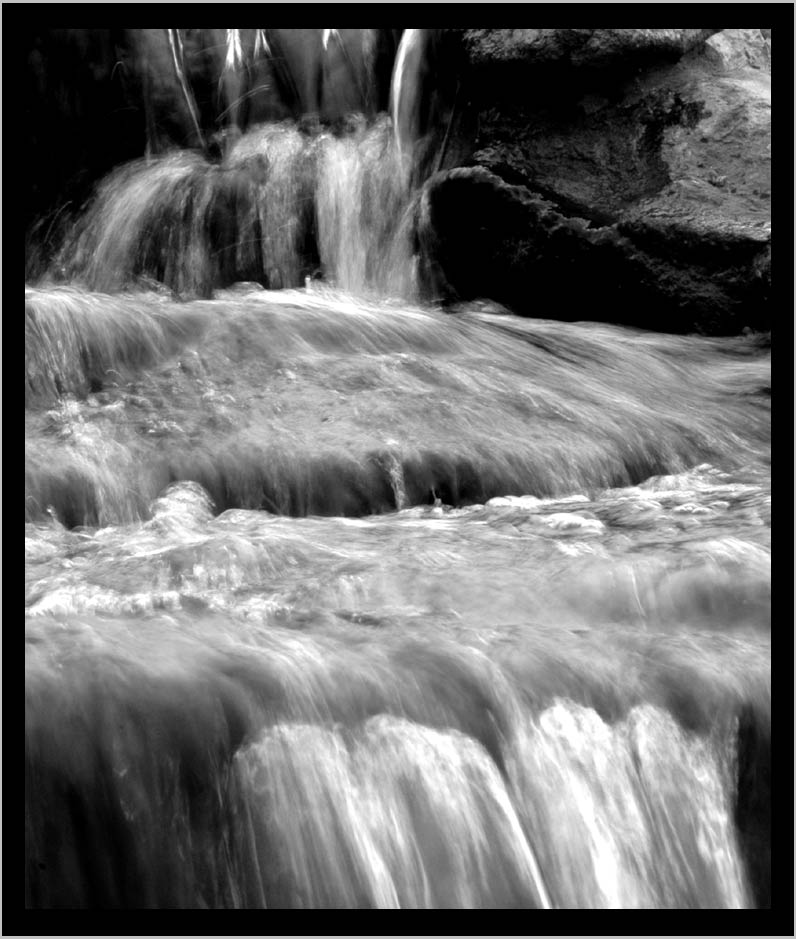
Wide Cascades . . . Autumn in North America.

Wide Cascades . . . Autumn in North America.
Water in flowing movement.... It is a rich source of images
for new ideas of organization in the Arts. Western culture
has had a long-standing bias with regard to movement
generally, favoring the power of masculine straight lines
over the rounded feminine curve, the predictable march
of a 4/4 lockstep over the ephemeral curves and eddies
of improvised time, or highly mechanized and measured
absolute, discrete staircases of pitches over the vocal
glides and glissandi which come so naturally to the singing
voice.* In short, Western culture seems to prefer the control
of water running through orderly metal pipes, or behind high
concrete dams, to the less predictable but far more balanced
generative chaos of complementarity.
All told, this amounts in my view to a very pervasive yet
almost entirely unconscious loss of femininity. Indeed,
if there is to be a new-found language of Lament in the
current era, this it seems to me must be one of its major
themes.
In poetry, think of all the mischief, real suffering and loss of
meaning which has been caused by conceptions of form which
have nothing to do with sound and movement, but merely patterns
of notation. The written page is one of our worst enemies. My rule with
students in both both poetry and music is:—first learn it by heart,
to free oneself from eye-based notational dominance.
In the early Rilke, before he had settled into the much
more rigid Sonnet form, there was a great deal of serious, yet
playful experimentation with what I think of as the parallel
movement of meaning and sound.
The following poem is from The Book of Hours, a work
of some 137 shorter pieces brought together in three sections.
All have the quality of a real pilgrim, that is, someone who
is not just repeating some path laid out by the authority
of the church, but one who is truly lost and urgently trying to
find his way, speaking directly to his God in laments, complaints
and prayers. They all have great passion; all seem to be written
in a single setting—almost a single breath, and a few might still be
considered masterpieces, even more than 100 years after
they were composed. This poem is one of those.
What is striking, I think, is the marvellous, perhaps almost
magical union of sound, movement and meaning. There are
many technical terms for the flow of resonances here, but all
serve to blind the ear to the marvellous weave of similarity
and difference which unfolds on the speaker’s breath, phrase
by phrase, like the twist and turns of a living stream.
It begins small, almost alone in one of those dark European
rooms of a vanished nobility with too much velvet and smoke-
encrusted paintings, but carries us all the way—each line
breaking into the next—to the depths of some bottomless
emotional sea. And all of this happens as the poem moves
powerfully towards, and then away from, one highly condensed
center:
Nowhere do I want to remain folded,
for where I am bent and folded, there I am lie.
Listen:
I am too alone in the world, and yet not alone enough
to make every hour holy.
I am too small in the world, and yet not tiny enough
just to stand before you like a thing,
dark and shrewd.
I want my will, and I want to be with my will
as it moves towards deed;
and in those quiet, somehow hesitating times,
when something is approaching,
I want to be with those who are wise
or else alone.
I want always to be a mirror that reflects your whole being,
and never to be too blind or too old
to hold your heavy, swaying image.
I want to unfold.
Nowhere do I want to remain folded,
for where I am bent and folded, there I am lie.
And I want my meaning
true for you. I want to describe myself
like a painting that I studied
closely for a long, long time,
like a word I finally understood,
like the pitcher of water I use every day ,
like the face of my mother,
like a ship
that carried me
through the deadliest storm of all..
Rainer Maria Rilke (tr. Cliff Crego)
composed in Berlin-Schmargendorf
September of 1899
| original German version |
*(There’s nothing complicated about any of this.
If you want to experience directly the difference, listen
to a Mozart violin concerto, say the 3rd, played by a real
master, like Menuhin in the past, or now Anne-Sophie Mutter
or Viktoria Mullova. Compare this to the vioilin as it is played
in the Indian classical tradition, say by Kala Ramnath.
See if you can get a hold of the differrence, but only after
repeatedly going back and forth between the musics and
performers of two very great, but very different, world cultures.)
NEW: To view / purchase different sized prints of this image at the
PhotoWeek Store click here. view as SLIDESHOW |
[http://www.shutterfly.com/pro/cliffcards/photoweek]
| back to Picture/Poems: Central Display | go to P/P Photoweek: Archive |
| Map | TOC: I-IV | TOC: V-VIII | Image Index | Index | Text Only | Download Page | Newsletter | About P/P | About Cliff Crego |
Photograph/Text/Translation by Cliff Crego © 2006 picture-poems.com
(created: IX.24.2005)